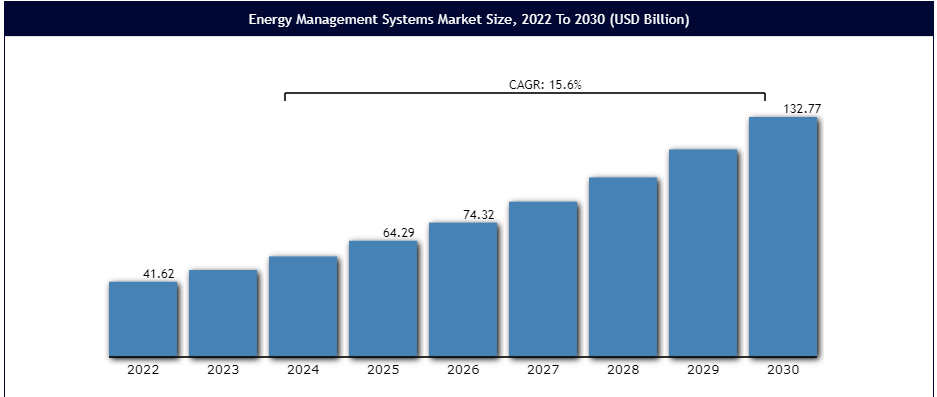
The Energy Management System (EMS) market in 2022 was valued at $41.62 billion, and is expected to reach $132.77 billion by 2030 at a CAGR of 15.60% over the forecast period 2023-2030.
According to the report, an Overview of the Energy Management System Market, the market is experiencing a significant surge in demand and innovation as organizations worldwide recognize the importance of efficient energy utilization.
EMS encompasses a set of tools, software, and services designed to monitor, control, and optimize energy performance in various sectors, including commercial, industrial, and residential. This market is primarily driven by the growing concerns about environmental sustainability and the need to reduce energy consumption and costs.
Market dynamics
The market is experiencing a number of issues including rising energy costs, environmental regulations, technological advancements, increased awareness of its benefits, push for renewable energy and market competition.
- Rising Energy Costs: Escalating energy prices are pushing organizations to adopt energy management systems to reduce their operational expenses and enhance profitability
- Environmental Regulations: Stringent environmental regulations are propelling the adoption of EMS solutions to limit carbon emissions and promote sustainability.
- Technological Advancements: Continuous advancements in EMS technology, such as IoT integration and smart sensors, are making energy management more efficient and accessible.
- Increased: Awareness: A growing awareness of the benefits of energy efficiency is driving businesses to invest in EMS solutions for long-term cost savings and a reduced carbon footprint.
- Global Push for Renewable Energy: The global shift toward renewable energy sources is encouraging the integration of EMS to optimize the use of green energy.
- Market Competition: The competitive landscape is intensifying as numerous players vie for a share of the expanding EMS market.
Top trends
- IoT Integration: The integration of Internet of Things (IoT) technology is enhancing real-time monitoring and control of energy consumption, leading to greater efficiency.
- Predictive Analytics: Predictive analytics tools are becoming increasingly essential, helping organizations anticipate energy demand and optimize resource allocation.
- Cloud-Based Solutions: Cloud-based EMS solutions are gaining popularity due to their scalability and ease of access from anywhere, fostering remote management.
- Demand Response: Demand response strategies are becoming more sophisticated, allowing companies to reduce energy consumption during peak periods to earn incentives. Artificial Intelligence: AI-driven EMS systems are automating decision-making processes, resulting in smarter, more efficient energy usage.
- Energy-Efficient Buildings: The construction of energy-efficient buildings with integrated EMS is on the rise, reducing long-term operational costs. Energy Storage Solutions: Battery storage and other energy storage technologies are complementing EMS, enabling energy load shifting and grid stabilization.
Challenges
- Initial Investment: The upfront costs associated with implementing EMS can be prohibitive for small and medium-sized businesses.
- Data Security: The collection and storage of sensitive energy data pose cybersecurity risks that need robust solutions.
- Lack of Expertise: Many organizations lack the in-house expertise to fully leverage EMS capabilities, leading to suboptimal results.
- Interoperability Issues: Compatibility problems between various EMS solutions and existing infrastructure can hinder seamless integration.
- Regulatory Complexity: Evolving energy regulations and standards may require frequent updates to EMS systems, creating administrative burdens.
Market opportunities
- Emerging Markets: Rapid industrialization and urbanization in emerging markets offer untapped potential for EMS adoption.
- Green Initiatives: Governments worldwide are supporting green initiatives, offering incentives for businesses to adopt energy-efficient practices and technologies.
- Energy Services Companies (ESCOs): ESCOs are partnering with organizations to provide turnkey energy management solutions, reducing the initial financial burden.
- Energy as a Service (EaaS): The EaaS model allows businesses to outsource their energy management, potentially simplifying operations and reducing costs.
In terms of the regional marketplace, Asia Pacific is a region of significant interest in the Energy Management System Market due to its rapid industrialization and economic growth.
The adoption of EMS in this region is driven by the increasing demand for energy and the necessity to manage it efficiently.
Countries like China, India, and Japan are at the forefront of embracing EMS solutions to optimize energy usage, reduce costs, and meet environmental targets. The Asia Pacific region presents a vast market for EMS providers, offering substantial growth potential in the coming years.








